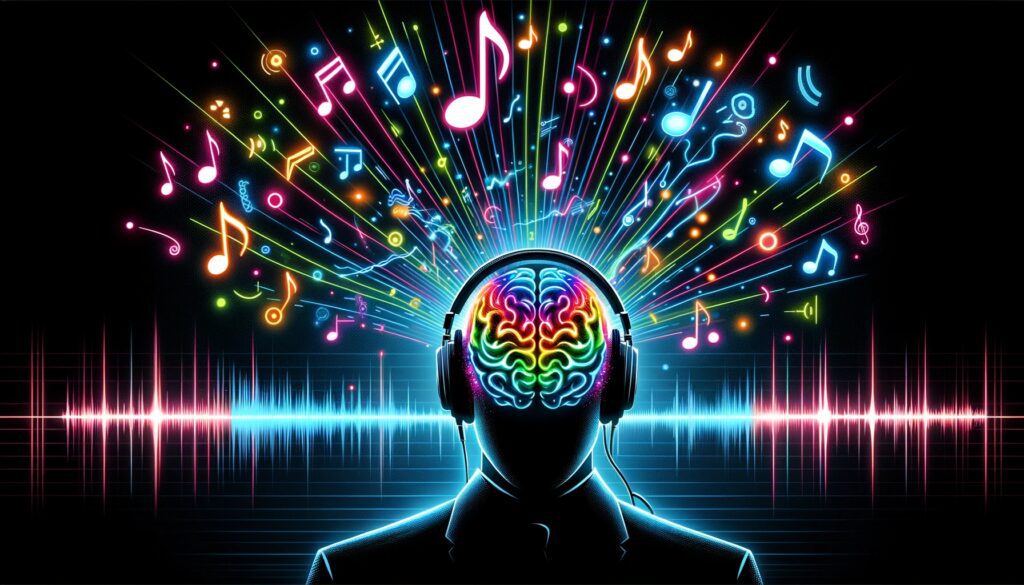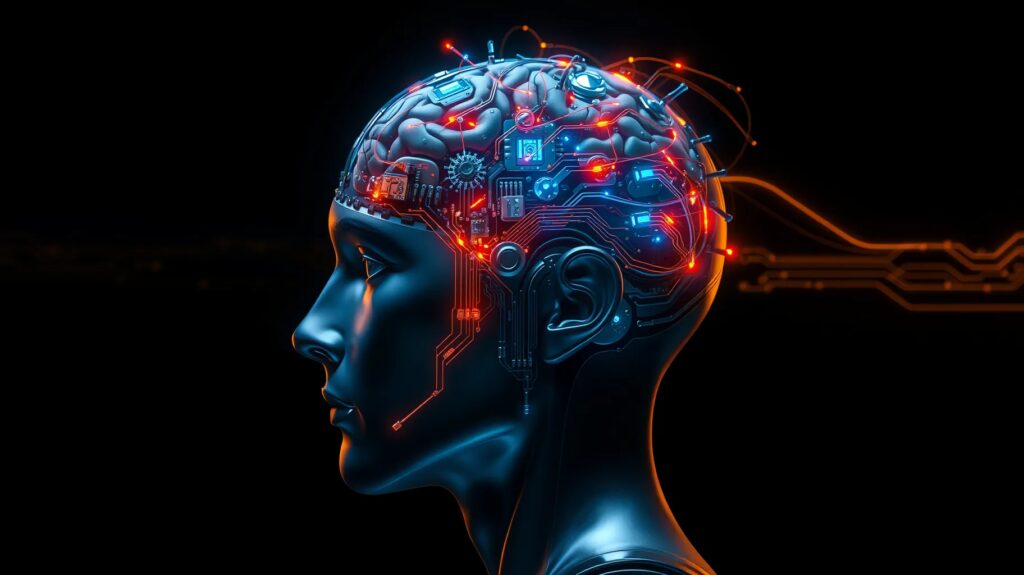
What Is a Brain-Computer Interface (BCI)? A brain-computer interface (BCI) is technology that allows the human brain to communicate directly with computers.
In simple terms, BCIs interpret brain activity into commands that a machine can understand. Recently, BCIs have been explored in various fields, but their role in music is especially exciting.
This new tech translates brain signals into sounds or digital commands, enabling musicians to create music with thought alone. BCIs offer accessibility for people with physical disabilities, opening doors to musical composition without traditional instruments.

Brain signals translate through a BCI system to produce musical compositions.
How BCIs Capture Brain Signals
BCIs capture brain activity using sensors placed on the scalp, most commonly in electroencephalography (EEG) headsets. These sensors detect electrical patterns in the brain, allowing computers to interpret the user’s intentions. Through training and repetition, the BCI system becomes more responsive to the user’s unique brainwave patterns.
The process may sound complex, but BCIs are becoming more user-friendly and portable, creating possibilities for a wider audience to experiment with mind-controlled music.
Why BCIs Are Becoming Popular in Music
The allure of hands-free music creation is attracting both musicians and technologists. BCIs allow artists to craft unique compositions using just brainwaves. The technology also offers a fresh way to experience music on a sensory level, creating deeper emotional connections between artists and listeners.
In a world that constantly seeks new forms of creative expression, BCIs stand out as tools that make music composition feel closer to magic than ever before.
How BCIs Transform the Music Composition Process
Composing Music with Thoughts
BCI technology lets users skip traditional instruments and instead “play” music using mental focus alone. For instance, an artist may concentrate on specific thoughts to create distinct notes or harmonies. Some BCIs can also manipulate tempo, pitch, and rhythm based on mental states like calmness or excitement.
Instead of playing an instrument, artists mentally shape soundscapes. This means that, for the first time, emotions become tangible tools in music creation, potentially creating sounds uniquely attuned to the artist’s state of mind.
Expanding the Boundaries of Musical Genres
Because BCIs allow for sound generation based on brainwaves, this technology is reshaping traditional genres. Musicians can now experiment with sounds that might not be possible using conventional methods, leading to new genres and styles in experimental and electronic music.
Imagine a song composed entirely from someone’s thoughts while meditating or feeling intense joy. This new frontier opens doors to music that feels almost “alive” with the energy of the creator’s mental and emotional state.
Enhancing Live Performances with Mind Control
BCIs are also transforming the live music experience. Artists can control aspects of their performance—such as visuals, lighting, or background effects—just by thinking. This makes concerts more immersive, with performers visually connected to their music in real time.
Through BCIs, live shows may soon involve interactive elements that change based on both the performer’s and audience’s collective mood, creating a new kind of connection.
BCIs for Music Therapy and Well-Being

Music as a Therapeutic Tool
Music has long been recognized for its therapeutic effects, helping people relax, process emotions, and improve cognitive functions. BCIs add a powerful layer to this, allowing patients to compose or experience music as a means of managing stress, anxiety, and other emotional challenges.
By translating mental states directly into music, BCIs help individuals connect with their emotions in a transformative way, enhancing the impact of music therapy. It’s not just listening to music—it’s creating music that resonates with your current mind-state.
Personalized Relaxation and Meditation Soundscapes
Imagine having a device that, based on your brainwaves, generates the perfect relaxation or meditation soundscape just for you. BCIs can capture and respond to users’ mental states in real time, adjusting melodies or rhythms to promote relaxation or focus.
For instance, if you’re feeling stressed, a BCI might detect this and respond by creating soothing sounds to help you calm down. This technology is revolutionizing relaxation techniques, giving people highly tailored and adaptable musical environments.
New Opportunities for Accessibility in Music Therapy
BCIs are also breaking barriers for individuals with limited mobility or speech abilities. For example, individuals recovering from strokes or those with neurodegenerative conditions may use BCIs to express themselves musically without the need for verbal or physical interactions.
This mind-to-music connection is proving invaluable in therapeutic settings, empowering individuals to experience the joy of creation and connect with others in new, expressive ways.
The Future of BCIs and Music Collaboration
Real-Time Collaboration Between Musicians
BCIs are setting the stage for musicians to collaborate in unique ways—by linking two or more brains directly. Using BCIs, musicians can create synchronized compositions by harmonizing their brainwaves, even if they are in different locations. Each musician contributes mentally, influencing shared soundscapes that evolve based on their collective neural signals.
This technology allows artists to tap into each other’s creative processes at a deeply intuitive level. Real-time collaboration with BCIs could pave the way for music that combines each participant’s thoughts, resulting in rich, multilayered sound experiences that go beyond traditional collaborative methods.
Audience Interaction in Live Shows
Another exciting frontier is audience participation. With BCIs, concerts could allow audiences to influence aspects of a live performance just by thinking. Imagine a BCI-equipped concert where audience brainwaves adjust the music’s tempo or color scheme based on collective excitement or calmness.
As technology advances, we may see live shows that truly feel like shared experiences, where listeners and performers influence each other in real time. Such interactions would redefine the idea of concerts as passive experiences and engage audiences in co-creating the event.
Integrating BCIs into Music Education

Enhancing Learning for Music Students
BCIs have the potential to revolutionize music education, making it more immersive and responsive. Imagine a student using a BCI to understand music theory or rhythm by observing their own brain’s response to different sounds and beats. By tracking mental engagement levels, teachers could adapt lessons to match the student’s focus and progress, creating a more personalized learning experience.
BCIs can also serve as valuable feedback tools for learning musical instruments. For example, a BCI could detect whether a student is anxious while learning a difficult piece and suggest calming techniques. This approach can help students connect more deeply with their musical journey and improve their focus and enjoyment.
New Tools for Composition and Creativity
For budding composers, BCIs open up new creative methods that weren’t possible before. By interpreting brainwaves directly, BCIs allow students to experiment with sounds and rhythms without needing extensive technical knowledge. Students can focus more on expressing emotions through music and less on technical barriers, which can be especially helpful for young learners or individuals with disabilities.
This technology gives students more freedom to explore music composition and encourages experimentation. With BCIs, students can create music intuitively, learning the art of composition by observing how thoughts and feelings influence sound.
Ethical and Privacy Considerations in Mind-Controlled Music
Data Privacy and Security Concerns
While BCIs in music offer exciting possibilities, they also bring up serious privacy issues. BCIs process sensitive data directly from users’ brains, raising concerns about data security. Who controls the data, and how securely is it stored? This is especially relevant for musicians and audiences who share personal, emotion-driven information.
Developers must prioritize robust data encryption and user privacy controls. Users need to be informed about how their data is used and should have options to delete or restrict access to personal information. Protecting mental data will be crucial as BCIs move from novelty to mainstream tools in the music industry.
Ethical Implications of Mind-Controlled Experiences
The idea of altering music and live performances based on mental states raises ethical questions around consent and manipulation. Could live performances become overly influenced by audience emotions, reducing artist autonomy? How much should our subconscious influence creative experiences?
As BCIs become more integrated into creative spaces, establishing ethical guidelines will help ensure that this technology respects the artist’s intent and audience’s experience. Transparency about how BCIs shape music is essential to preserve trust between creators and consumers.
Addressing Concerns for Emotional Well-Being
With BCIs making music more deeply connected to emotions, it’s essential to consider their effects on mental well-being. Music can evoke powerful feelings, and experiencing personalized or emotion-driven music could intensify emotional responses. This raises concerns about the potential for emotional overstimulation or unintentional psychological impact.
Developers and musicians should be mindful of these effects, especially in therapeutic or educational settings. Including safeguards that allow users to adjust or pause mind-controlled experiences can help make BCI-driven music safe and enjoyable for all.
The Road Ahead for BCI-Driven Music Experiences

Innovation and Accessibility
The future of BCIs in music is brimming with possibilities. As technology advances, costs are likely to decrease, making BCIs more accessible to everyday music lovers. We may soon see affordable BCI headsets designed for music composition, performance, and listening, making this once high-tech tool a part of daily life.
This accessibility will empower a broader range of creators, allowing musicians from all backgrounds to express themselves in new ways. Accessibility-focused developments could enable BCI adoption for anyone interested in music, regardless of their technical expertise or physical abilities.
Expanding Beyond Music to Other Art Forms
BCI applications in music might just be the beginning. The mind-control revolution is likely to extend to other art forms, like visual art and dance, where creators could shape their work with their mental states. Imagine an entire gallery of paintings crafted by artists’ brainwaves or dance performances where lighting and sound respond to dancers’ emotions.
These technologies could make the arts more immersive, interactive, and emotional. As BCIs grow in capabilities, they promise to transform how we experience all forms of creativity, bridging the gap between mind and artistic expression in ways we’ve only begun to imagine.
FAQs
Who can use BCI technology for music?
While BCI technology was initially developed for research and medical use, it’s becoming more accessible. Musicians, therapists, and hobbyists with basic BCI-compatible devices can experiment with mind-controlled music. BCIs are also designed to assist people with physical disabilities, offering a new way to create and enjoy music without traditional instruments.
Is mind-controlled music limited to certain genres?
Not at all. BCIs can produce a wide range of sounds, allowing for creativity in many genres. However, they are especially popular in electronic, experimental, and ambient music, where unconventional sounds fit naturally. As the technology develops, musicians are likely to explore even more genres.
Can BCIs help with music therapy?
Yes, BCIs have shown great potential in music therapy. By generating music that mirrors the user’s mental state, BCIs can aid in relaxation, stress management, and emotional processing. Therapists can also use BCIs to help patients express themselves musically without needing traditional instruments.
Are there privacy concerns with using BCIs in music?
Yes, privacy is a concern because BCIs capture sensitive brain data. This information, if not secured, could potentially be misused. Developers are working on security measures, but it’s essential for users to stay informed about how their data is stored and used.
Can audiences influence live performances with BCIs?
Yes, BCIs have introduced possibilities for audience interaction. In some cases, audience members with BCIs can influence aspects of a live show, such as lighting, visuals, or tempo. This turns concerts into more interactive experiences, though artists maintain control over the core performance.
Will BCIs become mainstream in the music industry?
BCIs are gaining popularity, especially in experimental and therapeutic music circles. As technology improves and costs decrease, BCI devices may become more mainstream in the music industry, making mind-controlled music a regular part of live shows, composition, and music therapy.
How accurate are BCIs at interpreting thoughts into music?
BCIs are becoming increasingly accurate, but the technology still requires training and adaptation to each user’s brain patterns. Through repeated use, the device learns to recognize specific brainwave patterns more accurately. However, the precision can vary depending on the quality of the BCI device and the user’s mental focus.
Can BCI technology be used by people without musical training?
Yes! One of the most exciting aspects of BCIs is that they allow people without traditional musical training to create music. Since BCIs translate thought patterns into sound, anyone can experiment with music-making, regardless of their musical background. However, the creative experience may differ from that of trained musicians.
How do emotions affect BCI-created music?
Emotions can significantly influence the music created through BCIs. Many devices can detect mental states like calmness, focus, and excitement, which then affect the musical output. For instance, feelings of excitement might create faster, more dynamic sounds, while calm thoughts could lead to soothing, ambient tones. This emotional connection adds a personal layer to BCI-driven music.
Do BCIs require physical contact with the head?
Most BCIs use EEG sensors that require contact with the scalp to capture brainwave activity, though advancements in non-invasive sensors are emerging. Some devices may need electrodes with conductive gel, while others work with dry sensors for ease and comfort. Research continues toward more user-friendly, even wireless, designs.
Are BCIs safe to use for long periods?
Yes, BCIs are generally safe when used as directed. They’re designed to be non-invasive and don’t emit any signals that interact with brain cells. However, as with any wearable tech, it’s best to use BCIs in moderation and follow manufacturer guidelines to avoid discomfort or fatigue.
Can BCI-driven music be recorded or shared?
Absolutely. Many BCIs can be connected to software that records the audio output. Artists can save, edit, and share their BCI-created compositions like any other digital music. This allows users to preserve their mind-created music and share it with others.
How much do BCI devices for music cost?
BCI devices vary widely in price. Basic consumer models that allow mind-controlled music creation start around a few hundred dollars, while advanced systems used in professional settings can cost thousands. As the technology becomes more common, prices are expected to decrease, making it more accessible for enthusiasts and musicians alike.
Can BCI technology be used with other instruments?
Yes, BCIs can be paired with other musical instruments. For example, musicians might use a BCI to control electronic synthesizers, modify effects, or add layers to live instrumentals. This creates a hybrid approach where traditional instruments and mind-controlled elements blend, expanding the creative possibilities.
Will BCI technology replace traditional instruments in the future?
BCIs are unlikely to fully replace traditional instruments but will complement them by offering new ways to create and experience music. Traditional instruments have a tactile and expressive quality that BCIs can’t replicate. Instead, BCIs add a novel dimension, allowing artists to combine traditional playing with mind-controlled elements for a richer, more varied musical experience.
Resources
- “What Are Brain-Computer Interfaces?” – Verywell Mind
A comprehensive introduction to BCIs, explaining how they work, applications, and their potential in fields beyond music, such as medical technology and communication. - “Music, Mind, and Health: How Music Affects the Brain” – National Institutes of Health (NIH)
This resource provides research-backed information on music’s effects on the brain, useful for understanding how BCIs can enhance the therapeutic potential of music. - “The Rise of Brain-Computer Interface Technology in Music” – IEEE Spectrum
Explore detailed articles on the latest advancements in BCI technology and its applications in creative fields like music and art, plus industry trends and research studies. - “Brain-Computer Interfaces: New Horizons for Music Therapy” – American Music Therapy Association
Focused on therapeutic uses of BCIs, this resource highlights how BCI technology can support individuals with physical or cognitive disabilities through music therapy. - “Neuromodulation of Brain Networks for the Creative Arts” – Frontiers in Psychology
A scientific journal that explores the intersection of neuroscience and creativity, including the impact of brainwave manipulation on music creation and other artistic expressions. - “How BCIs are Changing the Future of Music Creation” – MIT Technology Review
Provides up-to-date coverage on how BCIs are entering the creative arts, featuring interviews with artists and developers who work with mind-controlled music technologies. - “Brain-Controlled Music: Real-Time Composition Through BCIs” – PLOS ONE Journal
A detailed study that delves into how BCIs allow for real-time music composition, including case studies on musicians and how their thoughts translate into sounds. - Muse: The Brain-Sensing Headband – Muse Official Website
Muse produces consumer-grade EEG headbands that enable users to control music or monitor mental states for relaxation and focus, making BCIs accessible for everyday users interested in mind-driven technology.



